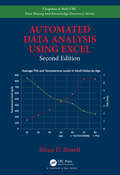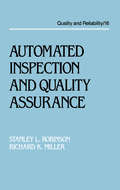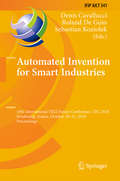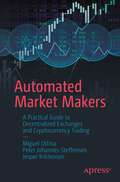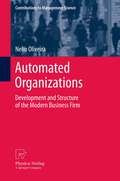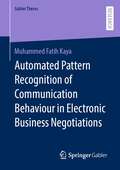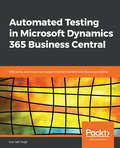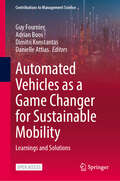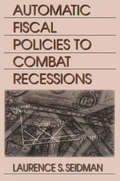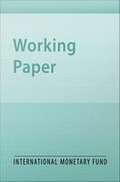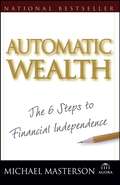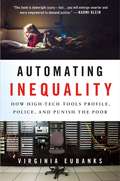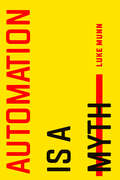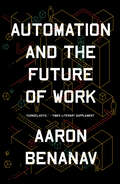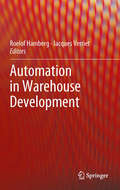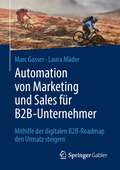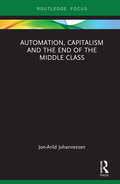- Table View
- List View
Automated Data Analysis Using Excel (Chapman & Hall/CRC Data Mining and Knowledge Discovery Series)
by Brian D. BissettThis new edition covers some of the key topics relating to the latest version of MS Office through Excel 2019, including the creation of custom ribbons by injecting XML code into Excel Workbooks and how to link Excel VBA macros to customize ribbon objects. It now also provides examples in using ADO, DAO, and SQL queries to retrieve data from databases for analysis. Operations such as fully automated linear and non-linear curve fitting, linear and non-linear mapping, charting, plotting, sorting, and filtering of data have been updated to leverage the newest Excel VBA object models. The text provides examples on automated data analysis and the preparation of custom reports suitable for legal archiving and dissemination. Functionality Demonstrated in This Edition Includes: Find and extract information raw data files Format data in color (conditional formatting) Perform non-linear and linear regressions on data Create custom functions for specific applications Generate datasets for regressions and functions Create custom reports for regulatory agencies Leverage email to send generated reports Return data to Excel using ADO, DAO, and SQL queries Create database files for processed data Create tables, records, and fields in databases Add data to databases in fields or records Leverage external computational engines Call functions in MATLAB® and Origin® from Excel
Automated Inspection and Quality Assurance (Quality And Reliability Ser. #16)
by Stanley L. Robinson Richard Kendall MillerNew concepts for gaging, inspection, checking, machine vision, and robotic testing. Includes guidelines for installing complex electronic and computerized systems and a directory of commercially availalbe computer software, as well as distributors' names and addresses. Annotation copyright Book News
Automated Invention for Smart Industries: 18th International TRIZ Future Conference, TFC 2018, Strasbourg, France, October 29–31, 2018, Proceedings (IFIP Advances in Information and Communication Technology #541)
by Roland De Guio Denis Cavallucci Sebastian KoziołekThis book constitutes the refereed proceedings of the 18th International TRIZ Future Conference on Automated Invention for Smart Industries, held in Strasbourg, France, in October 2018 and sponsored by IFIP WG 5.4.The 27 full papers presented were carefully reviewed and selected from numerous submissions. They are organized in seven thematic sections: teaching of TRIZ; TRIZ and knowledge represenations; biomimicry; strategic company management; association between TRIZ and other methods; TRIZ and the functional approach; and the use of patent or text populations as a data source.
Automated Market Makers: A Practical Guide to Decentralized Exchanges and Cryptocurrency Trading
by Miguel Ottina Peter Johannes Steffensen Jesper KristensenExplore Automated Market Makers (AMMs), the underlying protocols used by decentralized exchanges (DEX) to allow users to perform trades of cryptocurrencies in a decentralized way with no middlemen. This book provides a thorough study and a clear-cut exposition of the principal AMMs (Uniswap v2 and v3, Balancer, and Curve).You'll receive a detailed description of how these AMMs work, unveiling the mathematics behind them and showing plenty of examples as well as novel proofs for several interesting facts. Each chapter describes an AMM's core idea and derives the mathematical formulas used in the code, giving careful explanations of the logical thinking involved and detailing the steps needed to reach those formulas. All these explanations are complemented with thoughtfully chosen examples which further help to enlighten the readers on how the formulae work. In addition, the relevant parts of the codes of the AMMs are shown after explaining each formula so that the actual implementation of the formulae can be seen.In a traditional trading market a buy order has to be matched with a sell order to achieve a trade. However, for an AMM, users trade against the protocol itself, a smart contract, or a community pool of funds. In simple terms this is an open source computer program in which mathematical formulas define prices. Automated Market Makers examines this critical point revealing that no banks or intermediaries are necessary, giving crucial financial access to a much larger crowd, regardless of who they are with less barriers to access.What You'll LearnUnderstand the principals of decentralized finance (DeFi)Grasp mathematical formulae that underpin decentralized exchangesWork with Solidity programming languageReview current industry best practices Who This Book Is ForThose new to Blockchain and Cryptocurrency trading, who want to learn more about AMMsDevelopers who want to dive deeper into the core features of AMM platformsInvestors and venture capitalists who want to know more about new emerging technologies
Automated Organizations: Development and Structure of the Modern Business Firm (Contributions to Management Science)
by Nelio OliveiraThis book attempts to characterize a new organizational form that is now visible in many companies as a substitute of previous forms related to mechanized or mechanistic standards. The book is based on the approach of organizational structure and on Henry Mintzberg's work on organizational configurations. As a matter of fact, it attempts to supplement and update Mintzberg's organizational taxonomy, taking into account changes in the structure and work organization of business firms. The book is written for all people whose work is related to organizations and who are interested in the subjects it deals with.
Automated Pattern Recognition of Communication Behaviour in Electronic Business Negotiations (Gabler Theses)
by Muhammed Fatih KayaThe world of digitalisation is changing the way how people and business companies communicate with each other. Electronic negotiations represent one of the most important forms of business communication and can influence the successes and failures of companies in a significant way, whether in interorganisational or intraorganisational processes. Analysing negotiation interactions to determine pattern-based peculiarities in the communication offers new value-adding information concerning the management of optimised communication processes, even though the machine-based processing of communication data bears a series of challenges. The present book develops a new approach to analyse the automated pattern recognition potential of Machine Learning methods in unstructured negotiation communication. It presents holistic research frameworks for the effective detection of structural patterns and reveals the pattern labelling potential in high-dimensional communication data by analytically implementing a series of Machine Learning methods.
Automated Testing in Microsoft Dynamics 365 Business Central: Efficiently automate test cases in Dynamics NAV and Business Central
by Luc van VugtLearn how to write automated tests for Dynamics 365 Business Central and see how to implement it in your daily workKey FeaturesLeverage automated testing to advance over traditional manual testing methodsWrite, design, and implement automated testsExplore various testing frameworks and tools compatible with Microsoft Dynamics 365 Business CentralBook DescriptionDynamics 365 Business Central is the new cloud-based SaaS ERP proposition from Microsoft. It’s not as simple as it used to be way back when it was called Navigator, Navision Financials, or Microsoft Business Solutions-Navision. Our development practices are becoming more formal, and with this, the call for test automation is pressing on us.This book will teach you to leverage testing tools available with Dynamics 365 Business Central to perform automated testing. We’ll begin with a quick introduction to automated testing, followed by an overview of test automation in Dynamics 365 Business Central. Then you’ll learn to design and build automated tests and we’ll go through some efficient methods to get from requirements to application and testing code. Lastly, you’ll learn to incorporate your own and Microsoft tests into your daily development practice.By the end of the book, you’ll be able to write your own automated tests for Dynamics 365 Business Central.What you will learnUnderstand what automated tests are, and when and why to use themExplore the five pillars of the Testability Framework of Business CentralDesign and write automated tests for Business CentralMake use of standard automated tests and their helper librariesIntegrate automated tests into your development practiceWho this book is forThis book is for consultants, testers, developers, and development managers working with Microsoft Dynamics NAV and Business Central. Being a book on automated testing techniques, it also caters to both functional and technical development teams.
Automated Vehicles as a Game Changer for Sustainable Mobility: Learnings and Solutions (Contributions to Management Science)
by Danielle Attias Adrian Boos Dimitri Konstantas Guy FournierThis open access book explores a vision for a sustainable future in urban mobility through the AVENUE project, showcasing full-scale demonstrations of automated minibuses in European cities. AVENUE pioneers on-demand, door-to-door services, challenging traditional fixed bus itineraries. It delves into the implementation of automated vehicles, emphasizing safety, services, cybersecurity, and accessibility. Part two evaluates the economic, environmental, and social impacts on companies, citizens, and cities. By integrating automated vehicles into Mobility-as-a-Service and Intelligent Transport Systems, the book argues for the using of automated vehicles as game changer towards a transformative shift to sustainable, citizen-centric mobility. It advocates for efficiency, flexibility, and resilience of the transport system without imposing coercive transformation policies.
Automatic Fiscal Policies to Combat Recessions
by Laurence S. SeidmanDrawing on the most prominent research in the field, this timely book offers bold new fiscal policies that can complement current automatic stabilizers and counter-cyclical monetary policy to help combat recessions. Dr. Seidman argues for an independent fiscal policy board or the Federal Reserve to decide changes in the magnitude of Congress's fiscal policy package of stimulus or restraint, with recommendations going into effect immediately, subject only to Congressional override.
Automatic Stabilizers and the Size of Government: Correcting a Common Misunderstanding
by Annalisa Fedelino Carlo CottarelliA report from the International Monetary Fund.
Automatic Wealth: The Six Steps to Financial Independence (Agora Series #59)
by Michael Masterson"I have known Michael for over twenty years. He has one of the smartest business minds I know. When he gives me advice, I pay attention, and you should, too. Automatic Wealth is full of wisdom and insight filtered by a master and brought to you in a well-written and delightful style." -John Mauldin, Editor of the bestselling book, Just One Thing: Twelve of the World's Best Investors Reveal the One Strategy You Can't Overlook "I am not usually a fan of this kind of book. One entitled Automatic Wealth made me suspicious. But I am a fan of Michael Masterson, and when I read the book, I was impressed. Masterson manages to go beyond the theory to tell you exactly how real people make real money in the real world. That, I think, is his genius. He's able to open his own eyes and see for himself what actually works. The result is original, clever, and very helpful to anyone who is serious about building wealth." -Bill Bonner, coauthor of Empire of Debt: The Rise of an Epic Financial Crisis "Michael Masterson has been a great friend of mine for over twenty years. I know for a fact that the strategy he teaches is the exact same strategy he has personally used to amass extraordinary wealth and prosperity for himself. He's reduced a normally daunting process down to six simple and unfailing steps YOU can absolutely use to vastly and rapidly increase your financial situation, often times doubling and redoubling your wealth every few years. This book will become your financial bible." -Jay Abraham, author of Getting Everything You Can Out of All You've Got: 21 Ways You Can Out-Think, Out-Perform, and Out-Earn the Competition "Michael Masterson's book is brilliant and concise, packed with breakthrough insights and unique wealth-building tips. Best of all, it's practical because it combines proven investment and financial planning advice with street-smart business and real estate secrets." -Robert Ringer, author of Action!, Looking Out for #1, and To Be or Not to Be Intimidated?
Automating Finance: Infrastructures, Engineers, and the Making of Electronic Markets
by Juan Pablo Pardo-GuerraTrading floors are a thing of the past. Thanks to a combination of computers, high-speed networks and algorithms, millions of financial transactions now happen in fractions of a second. This book studies the automation of stock markets in the United Kingdom and the United States of America, identifying the invisible actors, devices, and politics that were central to the creation of electronic trading. In addition to offering a detailed account of how stock exchanges wrestled with technology, the book also invites readers to rethink the nature of markets in modern societies. Markets, it argues, are sites for the creation of relations, and in studying how these relations changed through technology, the book highlights the sources, dynamics, and consequences of automation. In this respect, the book is both a history of automation in finance and a sociological analysis of the way in which automation gradually changed the lives and work of key financial actors.
Automating Inequality: How High-Tech Tools Profile, Police, and Punish the Poor
by Virginia Eubanks<p>The State of Indiana denies one million applications for healthcare, foodstamps and cash benefits in three years—because a new computer system interprets any mistake as “failure to cooperate.” In Los Angeles, an algorithm calculates the comparative vulnerability of tens of thousands of homeless people in order to prioritize them for an inadequate pool of housing resources. In Pittsburgh, a child welfare agency uses a statistical model to try to predict which children might be future victims of abuse or neglect. <p>Since the dawn of the digital age, decision-making in finance, employment, politics, health and human services has undergone revolutionary change. Today, automated systems—rather than humans—control which neighborhoods get policed, which families attain needed resources, and who is investigated for fraud. While we all live under this new regime of data, the most invasive and punitive systems are aimed at the poor. <p>In Automating Inequality, Virginia Eubanks systematically investigates the impacts of data mining, policy algorithms, and predictive risk models on poor and working-class people in America. The book is full of heart-wrenching and eye-opening stories, from a woman in Indiana whose benefits are literally cut off as she lays dying to a family in Pennsylvania in daily fear of losing their daughter because they fit a certain statistical profile. <p>The U.S. has always used its most cutting-edge science and technology to contain, investigate, discipline and punish the destitute. Like the county poorhouse and scientific charity before them, digital tracking and automated decision-making hide poverty from the middle-class public and give the nation the ethical distance it needs to make inhumane choices: which families get food and which starve, who has housing and who remains homeless, and which families are broken up by the state. In the process, they weaken democracy and betray our most cherished national values. <p>This deeply researched and passionate book could not be more timely.</p>
Automating the Paris Subway (A)
by Elena Corsi Michel Anteby Emilie BillaudIn 2001, the head of the Paris Subway reflected on how to transform Line 1 into a driverless line without triggering a social conflict. After the shock of the 2000 Notre Dame de Lorette subway accident, in which a train derailed and caused 25 injuries in a Paris subway station, the state-owned Paris subway operator Regie Autonome des Transports Parisiens (RATP) decided to adopt new security measures and considered the opportunity to automate the oldest and the busiest line of the network. The Head of the Paris Subway, Serge Lagrange, believed that automating Line 1 would improve security as well as performance. However, the automation would bring about the downsizing of 219 drivers' positions. Lagrange had to figure out how to get the RATP employees on board, particularly drivers and trade unions. How could he convince them of the necessity to automate Line 1? How could he prevent the potentially major social conflict that might result from downsizing the drivers' positions?
Automating the Paris Subway (B)
by Elena Corsi Michel Anteby Emilie BillaudSupplement for case 413061
Automation Consulting Services
by Robert L. Simons Hilary A. WestonIllustrates the management control challenges that are associated with rapid growth and geographic expansion. Situated at an offsite Executive Committee Retreat. The three founding partners of a specialized consulting firm are grappling with several difficult questions and problems: 1) the tension between local office autonomy, entrepreneurship, and the need for a unified firm strategy; 2) the increasing need for standardized ways to monitor rising costs, capacity utilization, and new business development; 3) redefining the role of the Executive Committee and the role of formal systems as the partnership continues to grow.
Automation Consulting Services
by Robert L. Simons Hilary A. WestonIllustrates the management control challenges that are associated with rapid growth and geographic expansion. Situated at an offsite Executive Committee Retreat. The three founding partners of a specialized consulting firm are grappling with several difficult questions and problems: 1) the tension between local office autonomy, entrepreneurship, and the need for a unified firm strategy; 2) the increasing need for standardized ways to monitor rising costs, capacity utilization, and new business development; 3) redefining the role of the Executive Committee and the role of formal systems as the partnership continues to grow.
Automation Is a Myth
by Luke MunnFor some, automation will usher in a labor-free utopia; for others, it signals a disastrous age-to-come. Yet whether seen as dream or nightmare, automation, argues Munn, is ultimately a fable that rests on a set of triple fictions. There is the myth of full autonomy, claiming that machines will take over production and supplant humans. But far from being self-acting, technical solutions are piecemeal; their support and maintenance reveals the immense human labor behind "autonomous" processes. There is the myth of universal automation, with technologies framed as a desituated force sweeping the globe. But this fiction ignores the social, cultural, and geographical forces that shape technologies at a local level. And, there is the myth of automating everyone, the generic figure of "the human" at the heart of automation claims. But labor is socially stratified and so automation's fallout will be highly uneven, falling heavier on some (immigrants, people of color, women) than others. Munn moves from machine minders in China to warehouse pickers in the United States to explore the ways that new technologies do (and don't) reconfigure labor. Combining this rich array of human stories with insights from media and cultural studies, Munn points to a more nuanced, localized, and racialized understanding of the "future of work."
Automation and Autonomy: Labour, Capital and Machines in the Artificial Intelligence Industry (Marx, Engels, and Marxisms)
by James SteinhoffThis book argues that Marxist theory is essential for understanding the contemporary industrialization of the form of artificial intelligence (AI) called machine learning. It includes a political economic history of AI, tracking how it went from a fringe research interest for a handful of scientists in the 1950s to a centerpiece of cybernetic capital fifty years later. It also includes a political economic study of the scale, scope and dynamics of the contemporary AI industry as well as a labour process analysis of commercial machine learning software production, based on interviews with workers and management in AI companies around the world, ranging from tiny startups to giant technology firms. On the basis of this study, Steinhoff develops a Marxist analysis to argue that the popular theory of immaterial labour, which holds that information technologies increase the autonomy of workers from capital, tending towards a post-capitalist economy, does not adequately describe the situation of high-tech digital labour today. In the AI industry, digital labour remains firmly under the control of capital. Steinhoff argues that theories discerning therein an emergent autonomy of labour are in fact witnessing labour’s increasing automation.
Automation and the Future of Work
by Aaron BenanavA consensus-shattering account of automation technologies and their effect on workplaces and the labor marketSilicon Valley titans, politicians, techno-futurists and social critics have united in arguing that we are living on the cusp of an era of rapid technological automation, heralding the end of work as we know it. But does the much-discussed &“rise of the robots&” really explain the jobs crisis that awaits us on the other side of the coronavirus? In Automation and the Future of Work, Aaron Benanav uncovers the structural economic trends that will shape our working lives far into the future. What social movements, he asks, are required to propel us into post-scarcity, if technological innovation alone can&’t deliver it? In response to calls for a universal basic income that would maintain a growing army of redundant workers, he offers a counter-proposal.
Automation in Warehouse Development
by Roelof Hamberg Jacques VerrietThe warehouses of the future will come in a variety of forms, but with a few common ingredients. Firstly, human operational handling of items in warehouses is increasingly being replaced by automated item handling. Extended warehouse automation counteracts the scarcity of human operators and supports the quality of picking processes. Secondly, the development of models to simulate and analyse warehouse designs and their components facilitates the challenging task of developing warehouses that take into account each customer's individual requirements and logistic processes. Automation in Warehouse Development addresses both types of automation from the innovative perspective of applied science. In particular, it describes the outcomes of the Falcon project, a joint endeavour by a consortium of industrial and academic partners. The results include a model-based approach to automate warehouse control design, analysis models for warehouse design, concepts for robotic item handling and computer vision, and autonomous transport in warehouses. Automation in Warehouse Development is targeted at both academic researchers and industrial practitioners. It provides state-of-the art research on warehouse automation and model-based warehouse design. These topics have been addressed from a systems engineering perspective by researchers from different disciplines including software, control, and mechanical engineering, with a clear focus on the industrial applications of their research.
Automation of Trading Machine for Traders: How to Develop Trading Models
by Jacinta ChanThis Palgrave Pivot innovatively combines new methods and approaches to building dynamic trading systems to forecast future price direction in today’s increasingly difficult and volatile financial markets. The primary purpose of this book is to provide a structured course for building robust algorithmic trading models that forecast future price direction. Chan provides insider information and insights on trading strategies; her knowledge and experience has been gained over two decades as a trader in foreign exchange, stock and derivatives markets. She guides the reader to build, evaluate, and test the predictive ability and the profitability of abnormal returns of new hybrid forecasting models.
Automation von Marketing und Sales für B2B-Unternehmer: Mithilfe der digitalen B2B-Roadmap den Umsatz steigern
by Marc Gasser Laura MäderDie Automation von Marketing und Sales ist in Zukunft erfolgsentscheidend. Nur so können B2B-Unternehmen dem Wettbewerbsdruck weiterhin standhalten. Doch der Aufbau eines digitalen Marketing- und Salesprozesses ist aufwendig und komplex und stellt insbesondere kleinere B2B-Unternehmen vor die herausfordernde Frage: Wie kann die Digitalisierung möglichst kosteneffizient vorangetrieben werden? Anhand von Erfahrungswerten aus über 100 B2B-Digitalisierungsprojekten haben Laura Mäder und Marc Gasser das Modell der digitalen B2B-Roadmap entwickelt – eine Schritt-für-Schritt-Anleitung für die Planung, Steuerung und Skalierung von digitalem Marketing und Sales. Mithilfe der digitalen B2B-Roadmap Leads automatisiert entlang der Customer-Journey führen, einen Wettbewerbsvorteil erreichen und den Umsatz steigern. Dieses Buch ist für B2B-Unternehmer, Visionäre und Impulsgeber, die veraltete Marketing- und Salesmodelle auf den Kopf stellen und Innovation effizient vorantreiben wollen.
Automation, Capitalism and the End of the Middle Class (Routledge Focus on Economics and Finance)
by Jon-Arild JohannessenIn this book, the author argues that a new form of capitalism is emerging at the threshold of the Fourth Industrial Revolution. He asserts that we are in the midst of a transition from democratic capitalism to feudal capitalism and highlights how robotization and innovation is leading to a social crisis for the middle classes as economic inequality is on the rise. Johannessen outlines the three elements – Balkanization, the Great Illusion, and the plutocracy – which are referred to here as feudal structures. He describes, analyzes, and discusses these elements both individually and in interaction with each other, and asks: "What structures and processes are promoting and boosting feudal capitalism?" Additionally, the book serves to generate knowledge about how the middle class will develop in the Fourth Industrial Revolution. It shows the various effects of robotization on the middle class, where middle class jobs are transformed, deconstructed, and re-constructed and new part-time jobs are created for the middle class. Given the interest in the Fourth Industrial Revolution, the book will appeal to students of economic sociology and political economy as well as those in innovation and knowledge management courses focusing upon the emerging innovation economy. The topic will attract policymakers, and the accessible and engaging tone will also make the book of interest to the general public.
